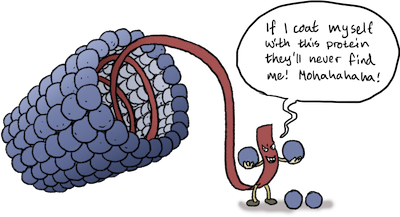I spent all of last week lying in my dorm room with the lights off. While that kind of break may sound like fun, it wasn’t. Like so many over the last few months, I was sick with the flu. In fact, 100 years after the worst flu pandemic in history, the United States is in the middle of what the New York Times is reporting as the worst flu epidemic in nearly a decade. According to the CDC there have been over 17,000 laboratory-confirmed, hospitalized cases of the flu since October 2017 and it may currently be causing as many as 4,000 deaths a week. Like many viruses, is not easy to treat the flu. The CDC recommends, rest, fluids, tylenol, and antiviral drugs like Tamiflu in severe cases to lessen the intensity of symptoms And while these treatments can help you feel better while you recover, viruses have no cure. So, what is it about viruses that makes them so hard to treat?
Like most living things viruses have genetic material made up of DNA or RNA depending on the virus, but they are not considered living. This is because they cannot reproduce on their own, instead they invade and take over a living cell.
Khan Academy has a very comprehensive, easy to read page on viruses. According to Kahn, “most viruses have three main components.” These three main components are a protein shell called a capsid, the nucleic acid genome – either DNA or RNA – and the membrane, commonly called the envelope. The exception to this is that not all viruses have envelopes, however for the sake of this post we will focus on the ones that do.
Virus capsids come in a variety of shapes and sizes but three common types are icosahedral which has 20 sides, Filamentous which looks like a thin thread, and a head-tail which is a combination of both.
Once a person is infected the virus travels through the body until it finds a host cell with the necessary proteins, called receptors. These receptors are like “locks” on the outside of the cell and if the virus has “keys” that match, then the virus attaches itself to the receptors on the cell’s membrane. Depending on the virus, either the virus or its genetic material will enter the host cell. Once the genetic material is inside the host cell the virus sets to work using the cell for genome reproduction and gene expression. This often means using what Khan Academy refers to as the “machinery” of the cell for reproduction, for example using the cell’s ribosomes to produce viral proteins. Next the viruses and the capsids they belong in are assembled, meaning new capsid proteins come together to form capsomers, which form full capsids. Depending on the virus some form capsids around the genetic material, others put the genetic material in the capsid after it is fully formed. Finally, the new virus is released from the cell. Sometimes the release of viruses kills the host cell, but other times the cell continues producing the virus and the virus goes on trying to infect more cells.
Viruses are difficult to treat because, once they get into your body, they use your cells to reproduce and you have to wait for your immune system to recognize them as in intruder and fight them off. There are no antibiotics for viruses, no pill you can take to kill the virus, just things to treat the symptoms. The best form of prevention is to get vaccinated. Vaccines give your immune system a sort of “practice run” so it’s recognizes the virus when you get sick and is ready to fight.
For help visualizing how viruses are made there are lots of colorful diagrams on the Khan Academy page I linked to above. There is also a beautiful animation provided by National Public Radio.
For a more interactive approach to learning about viruses than diagrams and videos, come see the WonderLab’s new Virus Assembly exhibit and see how capsids form. The exhibit made its debut in WonderLab’s gallery on January 30th, 2018.
Abby Bainbridge is studying Journalism with a concentration in Public Relations, as a member of IU’s class of 2021. She is a writing and content intern in the marketing department at WonderLab Museum of Science, Health and Technology. She is excited about The Patterns in Nature exhibit (aka the Virus Assembly Exhibit) which debuted in the gallery on January 30th, 2018.



Leave A Comment